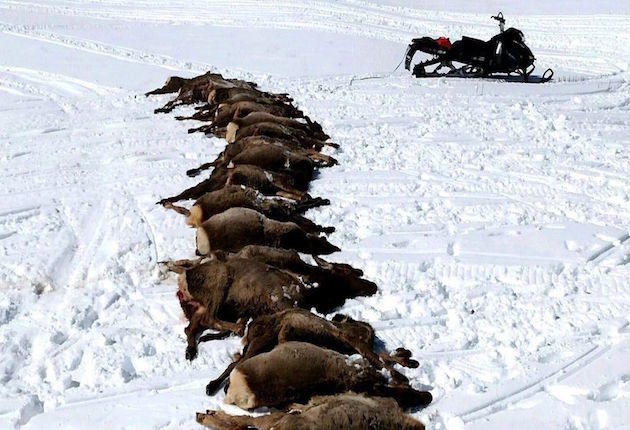While environmentalists bemoan any potential delisting of wolves from the Endangered Species List, the predators are making short work of Wyoming’s elk population. Wolves have reportedly decreased the state’s southwestern elk numbers by seven percent during the winter of 2015-16 alone.
Fish and Game’s John Lund was quoted in the Casper Star Tribune as saying, “We have had a lot of wolf predation on elk throughout our feedgrounds the last several years. This year has been significant, especially at that feedground. We’re estimating between 70 and 75 elk have been killed this year.”
According to CNN, the area holds about 1,100 elk.
The Washington Times reports that the department supplementally feeds the elk grass and alfala hay during the winters at a feeding station near Bondurant, along with 21 other stations across the state. Bondurant was the scene of an especially grisly incident recently, with a pack of wolves killing 19 elk for no apparent reason.
It happened sometime after the sun set on March 22. The “Rim Pack,” a group of nine wolves in the area, killed 17 calves and 2 adult cows, leaving the bodies largely intact with only a small amount of the meat actually eaten. The elk were discovered March 23.
Officials termed the incident a “surplus kill” — killing more than the wolves needed to eat. Wolves often kill without eating the resulting carcasses, but the state has never seen the act on such a large scale.
With the species’ placement on the Endangered Species List, only the federal government can take action against the Rim Pack. Their management is part of the U.S. Fish and Wildlife’s responsibilities, and while the feds can kill wolves when they attack cattle, elk killings fall outside the Service’s mandate under the Endangered Species Act.
Wyoming itself is unable to manage the situation and will remain so unless wolves are delisted in the future.
Lund told Fox News, “We can’t take any action proactively. It’s frustrating for state wildlife management.”
In the case of the 19 dead elk, officials removed them from the immediate feeding area but left them nearby. The wolves may return to feed on the carcasses, but biologists say they also may not since the bodies were handled by humans.
To the west, Oregon made a unilateral move in wolf management March 15. Gov. Kate Brown signed a bill delisting gray wolves within the state’s borders, backing a decision by the Oregon Fish and Wildlife in November. Similar efforts are underway in the Upper Midwest, with Wisconsin approving a wolf hunting season which will begin on the first Saturday in November each year … if the wolves are delisted.


This could be dogs or hybrids, not wolves. Not sure wolves kill for fun.
It’s time to open the season on these wolves.